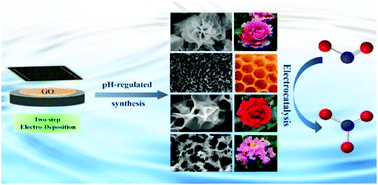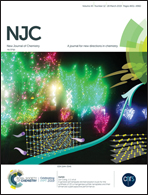pH-regulated synthesis of CuOx/ERGO nanohybrids with tunable electrocatalytic oxidation activity towards nitrite sensing†
Abstract
Designing low-cost and effective electrode materials is a pressing but challenging task for fabricating electrochemical sensors. Herein, a pH-regulated electrodeposition method was proposed for the facile synthesis of CuOx/electrochemically reduced graphene oxide (ERGO) nanohybrids. Besides, the relationships between the structures of CuOx/ERGO nanohybrids and the corresponding properties were investigated. It was found that the CuOx/ERGO nanohybrid-based electrochemical sensor displayed different catalytic abilities towards nitrite sensing, following the order honeycomb-like structure > peony-like structure > rose flower-like structure > crape myrtle flower-like structure. Honeycomb-like CuOx/ERGO nanohybrids were used to fabricate an electrochemical sensor. This sensor not only achieved accurate and sensitive detection of nitrite in a wide linear range of 0.1–100 μM with a low detection limit of 0.072 μM but could also be applied in the detection of nitrite in drinking water and meat samples with acceptable recovery and stability. The established method may have potential application value for on-site safety regulation on nitrite in the environment and food. And, research on the structure–property relationship of the electrode modified material has certain theoretical value for the development of new methods for electrocatalytic nitrite oxidation.



 Please wait while we load your content...
Please wait while we load your content...